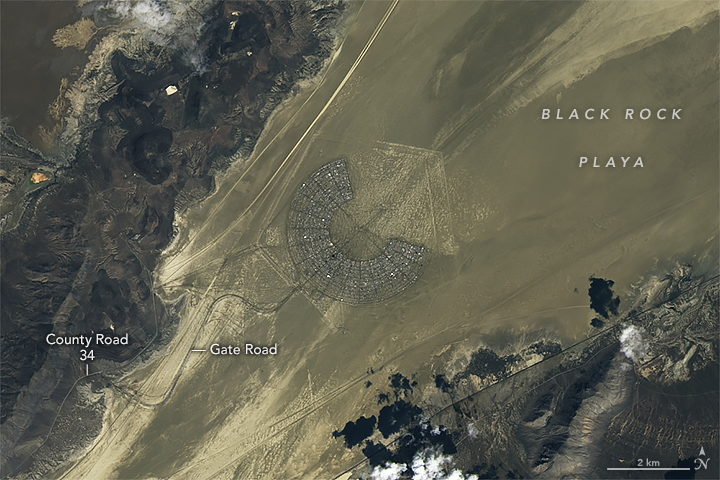
Summer Rains on Nevada’s Black Rock Playa
Downloads
- nevada_flood_tmo_2023238_lrg.jpg (2216x1477, JPEG)
- nevada_flood_tmo_2023247_lrg.jpg (2216x1477, JPEG)
- nevada_flooding_oli2_2023247_lrg.jpg (1159x773, JPEG)
Metadata
- Sensor(s):
- Terra - MODIS
- Landsat 9 - OLI-2
- Data Date: August 26, 2023 - September 4, 2023
- Visualization Date: September 7, 2023
Campers at Burning Man, an annual arts festival in Nevada’s Black Rock Desert, might typically expect to bake in the late summer sun on a dusty playa. In September 2023, however, attendees encountered a bout of unusually heavy rain that turned the pancake-flat desert basin into a sea of mud.
This image pair shows the desert on August 26 (left), the day before the festival began, and on September 4 (right), after several months’ worth of rain had fallen in the preceding days. The images use false color to make it easier to distinguish the presence of water. Saturated ground, silty water, and lakes appear in shades of blue, and vegetation is bright green. They were acquired by the Moderate Resolution Imaging Spectroradiometer (MODIS) on NASA’s Terra satellite.
The image below, also acquired on September 4, shows a detailed view of the area in natural color. Dark areas are likely mud, or where the surface is saturated with water. The image was acquired with the Operational Land Imager-2 (OLI-2) on Landsat 9.
Since 1990, festivalgoers have constructed a temporary settlement in the Black Rock Desert in late August and early September for the Burning Man gathering. The 2023 version of the camp is visible in the Landsat image above. It is situated in the middle of the Black Rock Playa, a flat, featureless expanse stretching northeast from the town of Gerlach for more than 30 miles (50 kilometers). The playa is a remnant of a large prehistoric lake, Lake Lahontan, which filled in a large portion of the Great Basin over 15,000 years ago.
In present times, rainfall along with snowmelt from surrounding mountains gathers into shallow pools on the playa in winter and early spring. With nowhere to go, the water feeds an aquatic ecosystem that includes fairy shrimp, tadpole shrimp, and water fleas. Typically, the water evaporates in warmer, drier months, leaving behind a solid surface. However, there have been recent exceptions to the seasonal cycles, when the playa has stayed dry in the winter months or wet in the summer.
On September 1, 2023, up to 1 inch (25 millimeters) of rain fell on the playa, according to news reports. On average, the area receives about 6 inches (150 millimeters) per year, with only 0.2 inches (5 millimeters) falling in September. The unseasonable rains were enough to transform the hard-packed desert floor into a muddy slurry in the middle of the Burning Man festival. By the morning of September 3, the surface was still too wet to drive on, according to updates issued by Burning Man, and additional drizzle and cloud cover slowed the drying-out process. By midday on September 4, tens of thousands of festivalgoers remained on the playa but were able to start driving out that afternoon.
The early-September storms in Nevada caused flooding in other parts of the state. Las Vegas received 0.88 inches (22 millimeters) of rain on September 1, a record amount for that day. Heavy rains triggered flash flooding in the city and forced the closure of Interstate 15 near the California-Nevada border.
References
- ABC News (2023, September 4) Burning Man flooding: What happened to stranded festivalgoers? Accessed September 7, 2023.
- CNN (2023, September 3) More than 70,000 Burning Man festival attendees remain stuck in Nevada desert after rain. Accessed September 7, 2023.
- Daily Press (2023, September 4) Traffic resumes after flooding shuts down Interstate 15 near California-Nevada border. Accessed September 7, 2023.
- U.S. Geological Survey (2022) Black Rock Playa, Nevada, USA. Accessed September 7, 2023.
- U.S. Geological Survey (2017) Wet-Dry Cycle. Accessed September 7, 2023.
NASA Earth Observatory images by Michala Garrison, using MODIS data from NASA EOSDIS LANCE and GIBS/Worldview, and Landsat data from the U.S. Geological Survey. Story by Lindsey Doermann.
This image record originally appeared on the Earth Observatory. Click here to view the full, original record.
